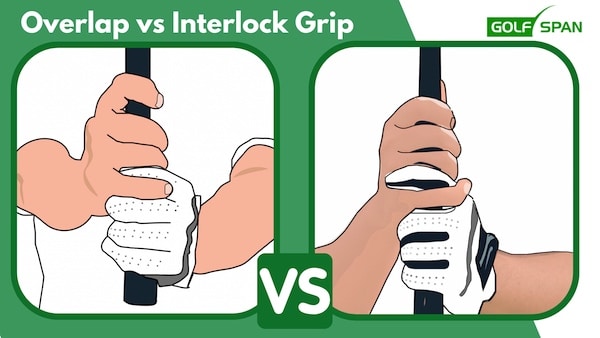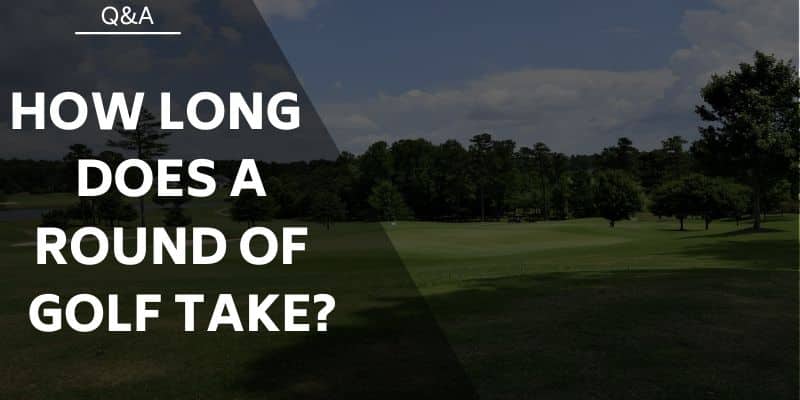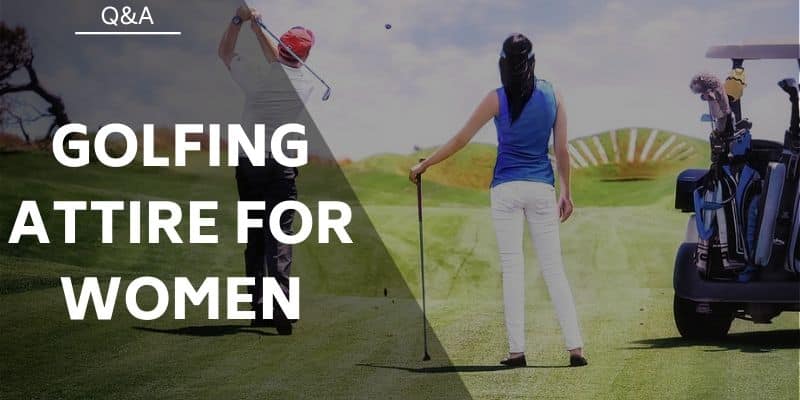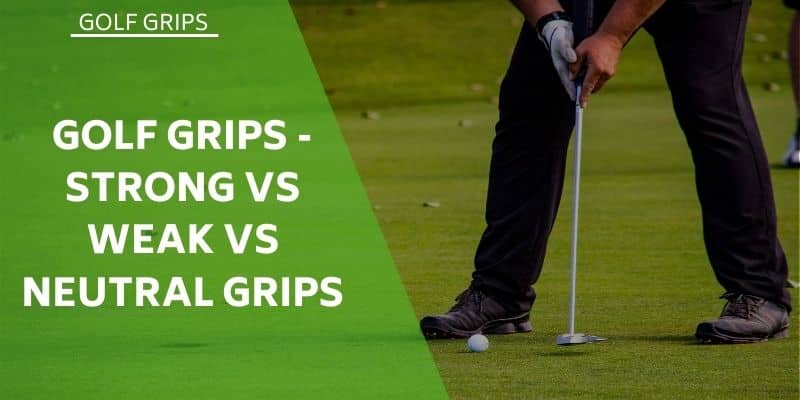3 basic golf grips have dominated the game over the years, and the interlock and overlap are the most popular and effective. The hammer or baseball grip is the 3rd grip which is not ideal for a player wanting to improve their golf.
It may be the easiest grip for beginners but should be changed. The interlock and overlap are not natural grips, but once mastered, game improvement will move rapidly.
The grip is possibly the most important fundamental of the game, as the hands are the only contact point with the golf club during the swing. It has to be mastered to be a better player. Sure, there are variations of each grip within the argument of overlap vs interlock grip, but the following points will help the golfer understand the importance and pick the right grip for them.
Interlock or Overlap Grip: Which Is Better?

In short, the interlock golf grip is better for those with smaller hands, while those with larger hands would likely feel more comfortable with an overlapping grip. Let’s dive into each a little further.
Overlap vs Interlock Grip: What Are the Differences?
The difference between these two grips is how the pinky is positioned on the dominant hand. With the overlap grip, the pinky rests between the groove of the nondominant hand’s middle and index finger. An interlocking grip means the pinky is placed fully between the two other fingers to lock the hands.
Interlock Grip
Pros:
- More control for players with smaller hands
- Creates natural strength
- Unity across hands
- Locks the hands in place
Cons:
- Uncomfortable for golfers with large hands
- Reduced power from lower wrist action
- Highlights posture and swing problems
The idea behind the interlock grip is to get the hands to work in unison, rather than against one another. Do this small test: Put the palms of both hands together and move the wrists in any direction, to get the feeling and understanding of working together or in unison. This is the way the wrists and hands should work when swinging a golf club.
Who Uses the Golf Interlock Grip?
Two of the greatest golfers of all time Jack Nicklaus and Tiger Woods use the interlocking grip. Nicklaus has small hands and fingers, and he believes he has more control in the hands during the swing. Rory McIlroy also uses the interlocking grip.
Many of the top LPGA golfers use the interlock, because of their small hands.
Who Should Use the Interlock Grip?
Players with small hands and short fingers should try this grip. For right-handed golfers, place the small finger of the right hand between the 1st and 2nd finger of the left hand, and close the hands on the club. You will notice that the palms of both hands are facing each other, just like the test we did earlier. This is the ideal position on the club for consistency and control during the swing.
What Are the Problems Experienced With the Interlock Grip?
Because it is a rather unnatural position for the fingers when interlocked, the pressure on the little finger of the right hand and the 1st and 2nd finger of the left hand, tend to become sore from the friction between the two.
The little finger of the right hand is also stretched a bit when holding the club and causes pain after long periods of use, like when practicing.
Beginners tend to hold the club too tightly in the palms of their hands, which causes problems reproducing the correct action through the swing.
Without even pressure between the hands on the club, the dominant hand will tend to take control and produce hooks or slices.
How To Cure Your Interlock Grip
Practice makes perfect, and never more so than this game of golf. Any new grip whether it be on a tennis racquet, hockey stick, or golf club takes time to get used to.
Persevere with the grip, and shorten the practice time at the beginning on the range.
Do drills anywhere by interlocking your hands as if holding a golf club, in order for the feeling to become more natural. Wear a soft golf glove on the left hand or on both (not recommended, but women do to protect their hands from the sun or callus forming).
Stick with it if you want to improve consistency with your game.
Overlapping Grip
Pros:
- More comfortable
- Suits golfers with large hands
- More power through the wrists
Cons:
- Wrist freedom can cause slices
- Players with smaller hands lack control with this grip
The overlapping golf grip was invented by a great English golfer by the name of Harry Vardon. The overlapping grip is often referred to as the Vardon Grip. It is the most used on the PGA Tour, and by amateurs.
It is very similar to the interlock, but instead of interlocking the little finger between the fingers, the little finger is placed over the top of the saddle between the index finger and middle finger on the left hand. Put another way, the 1st finger of the left hand is squeezed in between the pinky and 3rd finger of the right hand.
Who Should Use the Overlap Grip?
Golfers with large hands will feel more comfortable with the Overlap grip. The pressure within the grip can be controlled better, which all leads to consistency. The worst possible move within the swing is to re-grip or change pressure on the downswing.
This leads to over-the-top moves and puts the club out of the intended swing plane. Hooks, slices, and topped drives are the result. Many players believe the club can be released more naturally with the overlap grip. In some cases, less irritation between the fingers or fewer blisters occurs with this grip.
Are There Any Problems with the Overlap Grip?
Comfort with the grip chosen is paramount to producing consistency. Players with smaller hands use the overlap grip, whilst golfers with larger hands can also use the interlocking grip.
It is not uncommon for a golfer struggling with his swing, to try the opposite grip to what he normally plays. The pinky finger will feel the strain whether it interlocks or overlaps, but with time it becomes a natural movement.
Cure:
If the fingers feel strained, lessen the pressure in the grip. Alternatively, don’t overdo the practice sessions.
Hammer Grip or Baseball Grip
The other grip used mainly by beginners is the baseball or hammer grip. It is the first grip that beginners will take on the club. Mainly because it feels secure and stable. Unfortunately, many problems evolve, with the main one being holding the club too tight. This tightens up all the muscles in the arms, and upper body, which are “death” moves in the swing. Everything is restricted, and no fluency can be achieved in the swing.
Power is lost, leading to the beginner trying to overpower the ball rather than swing the club through the impact zone. I recommend beginner golfers change to the overlap or interlock grip as soon as possible. It may feel terribly uncomfortable initially but will yield better results sooner. The hammer grip will tend to let one hand dominate the grip pressure and allow the hands to work independently rather than in unison.
Reverse Overlap Grip
The reverse overlap golf grip is a variation applied mainly by golfers when putting. It puts the index finger of the left hand in the saddle of the 3rd finger and pinky of the right hand. There is no right or wrong putting grip in the modern game. Players on the Tour use whatever feels comfortable, and they will often change during a tournament if things are not going too well on the greens.
Which Grip Is Right For You?
There’s no exact science to picking interlock grip vs overlap. Overall, an overlap grip is better for big hands. If you have thick fingers or have overall bigger hands than most other people you know, try out an overlap grip. You can experiment with both and test the results for yourself. Get yourself to a driving range and find what works best.
Frequently Asked Questions
Is Overlapping Grip Better Than Interlocking?
For interlock vs overlap grip, it boils down to hand size. An interlocked grip provides more stability at the sacrifice of power. On the other hand overhand grip is way more comfortable for players with large hands.
Does Rory McIlroy Use Interlocking Grip?
Yes, Rory McIlroy uses an interlocking grip.
What Golf Grip Do Most Pros Use?
The overlap golf grip is the most common grip style among PGA pro golfers.
Can I Switch From One Grip to Another?
Yes, but we wouldn’t recommend trying this mid-tournament. You need to get a feel for each style. After some experimentation and learning how to grip a golf club best in each style, it is better to settle on one.
What Is the Best Grip for Putting?
There is no correct putting grip in modern golf, especially because there are so many different styles of putters on the market. Some popular putting grip styles are Left-hand low, Claw, and Arm-Lock.
Golf Grip: Overlap Vs Interlock – Final Thoughts
If I can encourage any beginner to make a change to their golf game, it is to make sure their grip is correct. In the professional ranks, pressure situations occur, like the final tee shot on the 18th hole, where OB and water come into play. If the Pros grip is not solid and comfortable, it will let him down at this crucial time. Pit the overlap vs interlock grip for yourself to establish what works best for you and PERSEVERE! You could also learn from a pro teacher in online lessons for advice.
Nick is the founder of GolfSpan and an avid golfer. He's not quite a pro but has over 15 years of experience playing and coaching golfers worldwide. His mission is to bring the golfing community a better experience when it comes to choosing the right golf gear and finding the right setup for your game.






